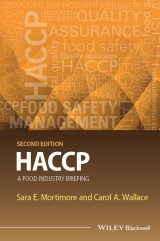Details

HACCP
A Food Industry Briefing2. Aufl.
|
43,99 € |
|
| Verlag: | Wiley-Blackwell |
| Format: | EPUB |
| Veröffentl.: | 27.03.2015 |
| ISBN/EAN: | 9781118427200 |
| Sprache: | englisch |
| Anzahl Seiten: | 192 |
DRM-geschütztes eBook, Sie benötigen z.B. Adobe Digital Editions und eine Adobe ID zum Lesen.
Beschreibungen
<p>Readers of this accessible book – now in a revised and updated new edition – are taken on a conceptual journey which passes every milestone and important feature of the HACCP landscape at a pace which is comfortable and productive. The information and ideas contained in the book will enable food industry managers and executives to take their new-found knowledge into the workplace for use in the development and implementation of HACCP systems appropriate for their products and manufacturing processes.</p> <p>The material is structured so that the reader can quickly assimilate the essentials of the topic. Clearly presented, this HACCP briefing includes checklists, bullet points, flow charts, schematic diagrams for quick reference, and at the start of each section the authors have provided useful key points summary boxes. <i>HACCP: a Food Industry Briefing</i> is an introductory-level text for readers who are unfamiliar with the subject either because they have never come across it or because they need to be reminded. The book will also make a valuable addition to material used in staff training and is an excellent core text for HACCP courses.</p>
<p>Disclaimer ix</p> <p>Preface xi</p> <p><b>Section 1 Introduction to HACCP 1</b></p> <p>Frequently asked questions 2</p> <p>1.1 What is HACCP? 2</p> <p>1.2 Where did it come from? 2</p> <p>1.3 How does it work? 3</p> <p>1.4 What are the seven HACCP principles? 3</p> <p>1.5 Is it difficult to use? 4</p> <p>1.6 Why use it? 4</p> <p>1.7 What type of company would use HACCP? 5</p> <p>1.8 Are there any common misconceptions? 9</p> <p>1.9 How do we know HACCP works? 10</p> <p>1.10 What actually gets implemented in the workplace? 11</p> <p>1.11 How does a HACCP plan get written? 11</p> <p>1.12 Who carries out the HACCP study? 12</p> <p>1.13 What is the regulatory position of HACCP? 12</p> <p>1.14 Are there other driving forces for the use of HACCP? 14</p> <p>1.15 What does it cost? 15</p> <p>1.16 What is third?]party certification? 16</p> <p>1.17 Is there anything more that I should know? 16</p> <p><b>Section 2 The HACCP system explained 17</b></p> <p>2.1 HACCP system overview – How does it all fit together? 18</p> <p>2.2 HACCP in the context of other management systems – What is HACCP and what is not? 21</p> <p>2.2.1 Business management practices 22</p> <p>2.2.2 Prerequisite programmes 25</p> <p>2.2.3 Quality management systems for effective operation and process control 29</p> <p>2.3 How do you get started with HACCP – The preparation and planning stage 32</p> <p>2.3.1 Management commitment, personnel and training 33</p> <p>2.3.2 Baseline audit 36</p> <p>2.3.3 Planning the HACCP project 37</p> <p><b>Section 3 HACCP in practice 41</b></p> <p>3.1 Preparation for the HACCP plan development 42</p> <p>3.1.1 Terms of reference 43</p> <p>3.1.2 Describe the product and intended use 45</p> <p>3.1.3 Construction and validation of a process flow diagram 49</p> <p>3.2 Applying the principles 50</p> <p>3.2.1 Principle 1: Conduct a hazard analysis – What can go wrong? 50</p> <p>3.2.2 Principle 2: Determine the Critical Control Points (CCPs) – At what stage in the process is control essential? 62</p> <p>3.2.3 Principle 3: Establish critical limit(s) – What criteria must be met to ensure product safety? 68</p> <p>3.2.4 Principle 4: Establish a system to monitor control of the CCP – What checks will indicate that<br />something is going wrong? 69</p> <p>3.2.5 Principle 5: Establish the corrective action to be taken when monitoring indicates that a particular CCP is not under control – If something does go wrong what action needs to be taken? 73</p> <p>3.2.6 Principle 6: Establish procedures for verification to confirm that the HACCP system is working<br />effectively – How can you make sure that the system is working in practice? 75</p> <p>3.2.7 Principle 7: Establish appropriate documentation concerning all procedures and records appropriate<br />to those principles and their application – How can you demonstrate (if challenged) that the system works? 79</p> <p>3.3 Implementation of the HACCP plan 82</p> <p>3.4 Maintenance of the HACCP system 87</p> <p>3.5 Third?]party certification of food safety management systems 89</p> <p>3.6 Conclusion 89</p> <p>Epilogue 91</p> <p>Appendix A: Case study: Chilled and frozen cheesecake production 103</p> <p>Appendix B: Acronyms and glossary 153</p> <p>References 159</p> <p>HACCP Resources 161</p> <p>Index 165</p>
<p><b>Sara E. Mortimore</b> is Vice President, Product Safety, Quality and Regulatory Affairs, Land O’Lakes, Inc., Saint Paul, Minnesota, USA</p> <p><b>Carol A. Wallace</b> is Co-Director of the International Institute of Nutritional Sciences and Applied Food Safety Studies at the University of Central Lancashire, Preston, UK</p>
<p>Readers of this accessible book – now in a revised and updated new edition – are taken on a conceptual journey which passes every milestone and important feature of the HACCP landscape at a pace which is comfortable and productive. The information and ideas contained in the book will enable food industry managers and executives to take their new-found knowledge into the workplace for use in the development and implementation of HACCP systems appropriate for their products and manufacturing processes.</p> <p>The material is structured so that the reader can quickly assimilate the essentials of the topic. Clearly presented, this HACCP briefing includes checklists, bullet points, flow charts, schematic diagrams for quick reference, and at the start of each section the authors have provided useful key points summary boxes. <i>HACCP: a Food Industry Briefing</i> is an introductory-level text for readers who are unfamiliar with the subject either because they have never come across it or because they need to be reminded. The book will also make a valuable addition to material used in staff training and is an excellent core text for HACCP courses.</p>


















